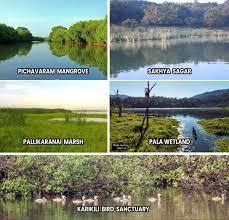India Has Added Five More Ramsar Sites:

India has added five more Ramsar sites, or wetlands of international importance, bringing the number of such sites to 54.
New Ramsar Sites:
Karikili Bird Sanctuary (Tamil Nadu):
- The sanctuary is spread over a five-kilometre-wide belt and is home to cormorants, egrets, grey heron, open-billed stork, darter, spoonbill, white lbnis, night herons, grebes, grey pelican among others.
Pallikaranai Marsh Reserve Forest (Tamil Nadu):
- One of the last remaining natural wetlands, the marsh drains in an area of 250 square kilometres encompassing 65 wetlands.
- The Pallikaranai Marsh is one of the few natural coastal aquatic habitats that qualify as a wetland in India.
Pichavaram Mangrove (Tamil Nadu):
- One of the last mangrove forests in the country.
- It has an island of a vast expanse of water covered with mangrove forests.
Sakhya Sagar (Madhya Pradesh):
- Created from the Manier river in 1918, Sakhya Sagar is located near Madhav National Park.
Pala Wetland in Mizoram (Mizoram):
- It is home to a wide range of animals, birds, and reptiles.
- Its geographical location falls under the Indo-Burma biodiversity hotspot and is therefore rich in animal and plant species.
- The lake is a major component of the Palak Wildlife Sanctuary and it supports the major biodiversity of the sanctuary.
Ramsar site :
- It is a wetland of international importance under the Ramsar Convention, which is also known as the ‘Convention on Wetlands’ — an intergovernmental environmental treaty established by UNESCO in 1971, and named after the city of Ramsar in Iran, where the convention was signed that year.
- Ramsar recognition is the identification of wetlands around the world, which are of international importance, especially if they provide habitat to waterfowl (about 180 species of birds).
- There is international interest and cooperation in the conservation of such wetlands and a judicious use of their resources.
- Sundarbans in West Bengal is the largest Ramsar site in India.




